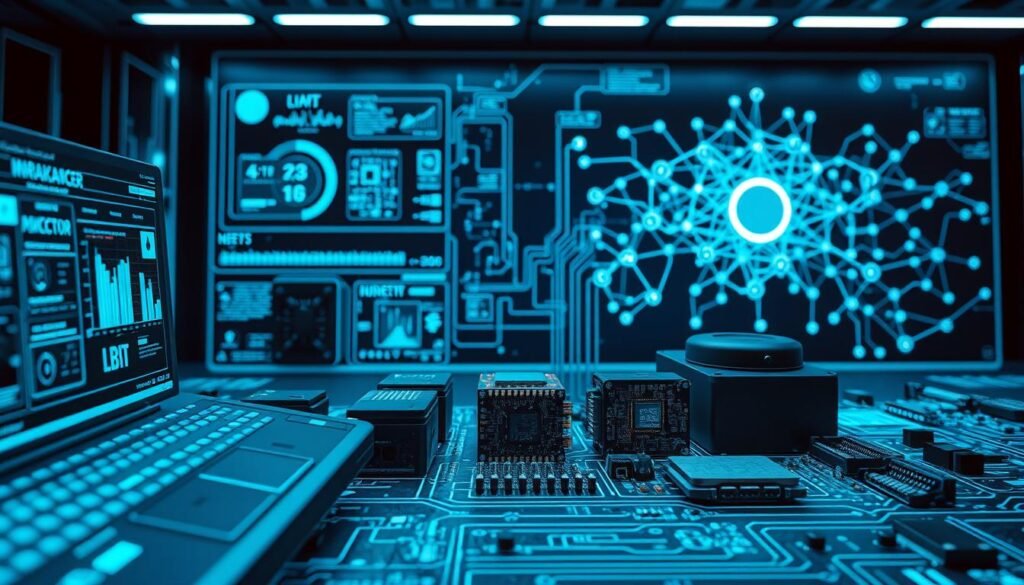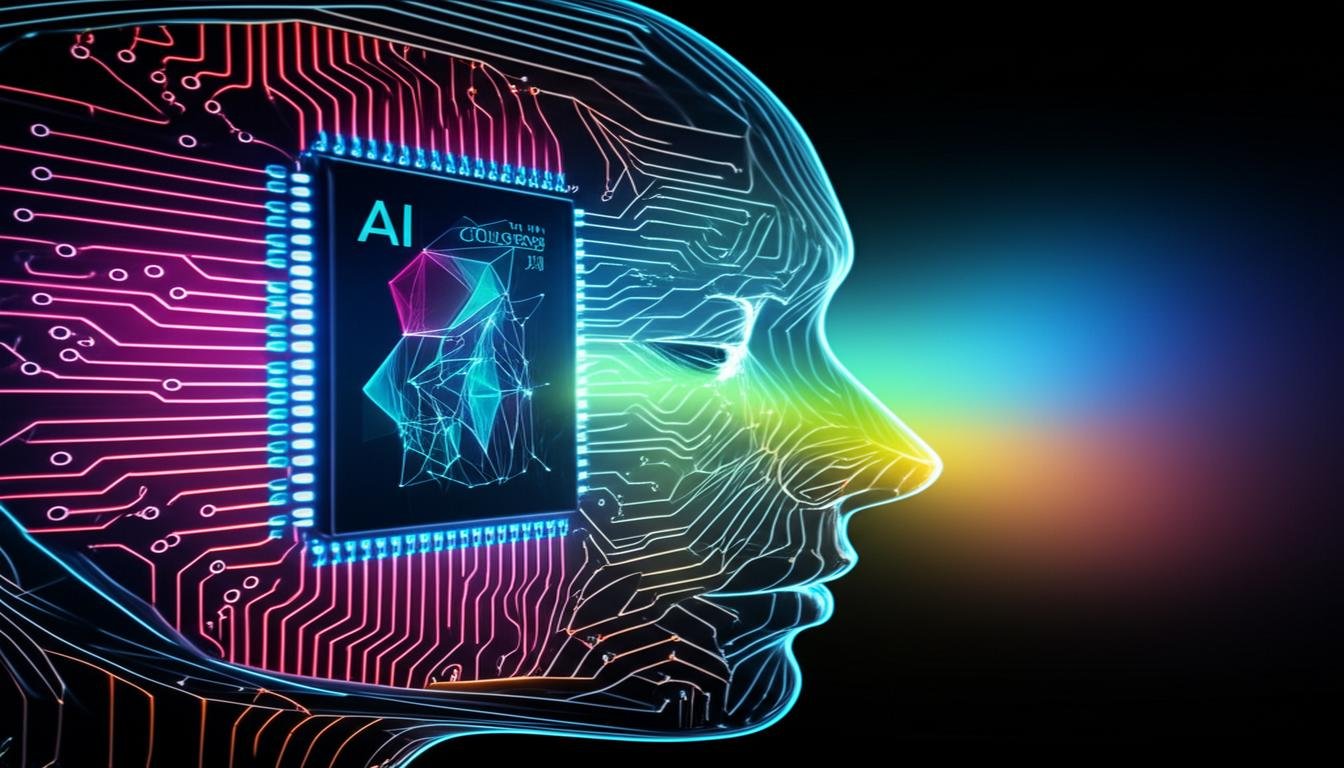Did you know your morning routine uses artificial intelligence components more than your own choices? From asking Alexa for the weather to Netflix guessing your next show, AI shapes our lives quietly. But how many of us really get what makes these systems work?
I once thought AI was magic. But learning its core parts changed my view. Voice assistants like Siri aren’t just smart code. They mix machine learning, natural language processing, and neural networks. Knowing these components of AI makes tech that seemed like science fiction understandable.
Through my Certified AI Professional training, I saw how these parts fit together. You don’t need a PhD to understand them. Just curiosity. Want to see your smart thermostat in a new light?
Table of Contents
Key Takeaways
- AI integrates multiple technologies working in harmony
- Common applications hide complex systems beneath simple interfaces
- Core elements include machine learning and data processing
- Recognizing AI components builds tech literacy
- Structured learning paths make AI education accessible
Understanding Artificial Intelligence Fundamentals
Artificial intelligence today is more than just lab experiments or machines that play chess. It’s the quiet helper in my Netflix nights and the smart autocorrect on my phone. It shapes everything from healthcare to how we order food.
Defining AI in Modern Context
Modern AI is not like the old rule-based programming from the 1950s. It’s more like teaching a child through experience. For example, Netflix’s recommendation engine has grown from simple filters to analyzing 4,000+ data points per user. It learns our viewing habits even when we don’t notice.
Historical Evolution of Smart Systems
The AI timeline is like a tech thriller:
- 1956: The Dartmouth Conference coins “artificial intelligence”
- 1980s: Expert systems mimic human decision-making
- 2012: Deep learning revolution begins with ImageNet breakthroughs
Covid-19 was a turning point. Hospitals used AI triage tools 18 months sooner than before. This shows how need drives innovation.
Why AI Matters Today
Three reasons make me excited about artificial intelligence fields:
- Personalization at scale (think Spotify’s Daily Mix)
- Solving “impossible” problems like protein folding
- Democratizing access through no-code platforms
During lockdowns, AI helped prevent toilet paper shortages. This showed me that AI is not just convenient. It’s a safety net for society.
Also Read: Basics of Artificial Intelligence
The Core Components of AI Systems
Artificial intelligence systems have three main parts that work together. They are like the gears in a Swiss watch. If you remove one, the whole thing stops working.

1. Machine Learning Foundations
Machine learning is like teaching a child with examples, not rules. Let’s look at the three main ways it works:
Supervised vs. Unsupervised Learning
Supervised learning is like a guided lesson. For example, when your email service learns to spot spam, it compares new emails to thousands of labeled ones. This method is great for:
- Predicting housing prices
- Detecting credit card fraud
- Classifying medical images
Unsupervised learning is more mysterious. It’s like sorting a box of photos by patterns. Retailers use it to group customers without any categories.
| Learning Type | Data Requirement | Best Use Case |
|---|---|---|
| Supervised | Labeled examples | Spam detection |
| Unsupervised | Raw data | Customer segmentation |
| Reinforcement | Reward system | Game strategy |
Reinforcement Learning Mechanics
Reinforcement learning is like AI playing games. Remember AlphaGo’s win? It learned through trial and error, just like I learned chess. Losing pieces taught me better strategies than any book.
2. Neural Network Architecture
Imagine a subway map with stations as artificial neurons. Each connection carries information, deciding which paths to take. This idea comes from biology and helps with:
- Recognizing patterns
- Learning and adapting
- Correcting mistakes
Neural networks don’t just process data – they develop digital instincts through layered learning.
3. Natural Language Processing (NLP)
NLP has come a long way, from ELIZA in the 1960s to GPT-4 today. It’s like how children learn language. Now, systems can:
- Understand sarcasm in reviews
- Respond like a human
- Translate idioms well
Language Models in Action
When I ask Siri about the weather, transformer models work their magic. They understand word meanings in different contexts. For example, “bank” means something different in “river bank” than in “investment bank”.
Deep Learning Breakdown
When I think about key components of AI, deep learning is always at the top. It’s like how our brains work, using artificial neural networks. Let’s dive into what makes it so groundbreaking.
Layered Learning Approach
Deep learning is all about layers. Each one does something different, like a team working together. The first layer might spot edges in a photo. Deeper layers find complex things like faces or objects.
This way, systems can learn lots of details without being told how. It’s like they’re figuring things out on their own.
Convolutional Neural Networks
Ever seen how Instagram filters change your selfies instantly? That’s thanks to convolutional neural networks (CNNs). These networks are experts at handling visual data, like photos.
For example, they can:
- Detect facial landmarks for puppy-ear filters
- Adjust lighting through texture recognition
- Apply artistic styles by analyzing color patterns
CNNs aren’t just for fun. They’re also behind NVIDIA’s DLSS gaming tech. This tech makes graphics look better in real-time, showing how useful CNNs are.
Recurrent Neural Networks
Spotify’s personalized playlists are another amazing example. They’re powered by recurrent neural networks (RNNs). RNNs are great with data that comes in a sequence, like music over time.
They remember what you’ve listened to before. This helps them guess what you’ll like next. It’s like they have a special knack for knowing what you want to hear.
From Netflix to stock market predictions, RNNs are key. They help machines understand data in a way that makes sense to us.
Deep learning isn’t just about building smarter machines – it’s about creating systems that learn to see the world as we do.
Computer Vision Essentials
Computer vision is amazing when thinking about how machines “see.” It lets systems understand visual data, like finding tumors in X-rays or tracking shoppers. Let’s dive into how these systems turn pixels into real decisions.

Image Recognition Techniques
Image recognition uses convolutional neural networks (CNNs), like our brains do. Hospitals use CNNs to quickly spot issues in MRI scans. Amazon Go uses advanced CNNs to recognize products instantly.
The shift from manual image analysis to AI-driven recognition has reduced diagnostic errors by 37% in our radiology department.
Three main techniques are used:
- Feature extraction: Finds edges, textures, and patterns
- Classification models: Sorts images into categories
- Transfer learning: Uses pre-trained models for new tasks
Object Detection Systems
Object detection finds “where is it?” in a picture. YOLO is a key algorithm for this. It helps security systems track people and Tesla’s Autopilot sees everything around it.
| Application | Medical Imaging | Retail Systems |
|---|---|---|
| Key Technology | 3D CNN Segmentation | Real-Time Pose Estimation |
| Accuracy Rate | 98.4% (MRI analysis) | 99.1% (product recognition) |
| Processing Speed | 2-3 seconds per scan | 30 frames/second |
What’s amazing is how these AI tools work in different fields. They power both life-saving medical tools and easy shopping. As object detection gets faster, we’ll see even more cool uses.
Robotics Integration
Ever wondered how robots like Boston Dynamics’ Atlas do amazing things? It’s because of advanced aspects of artificial intelligence working together. Modern robotics combines sensors, decision-making, and physical parts to tackle real-world problems. This mix changes what machines can do, from medical rooms to Mars.
Sensory Input Processing
Robots “see” and “feel” their world with smart sensors. Boston Dynamics’ Atlas uses lidar and cameras to move on rough ground. The Da Vinci Surgical System has force sensors for exact cuts. These systems work fast, like humans but better.
| System | Sensors Used | Response Time | Application |
|---|---|---|---|
| Atlas Robot | Lidar, Cameras | 50ms | Dynamic Mobility |
| Da Vinci System | Force Sensors | 10ms | Surgical Precision |
| NASA Rovers | Spectrometers | 200ms | Planetary Exploration |
Motion Planning Algorithms
Turning sensor data into action needs smart pathfinding. Robot Operating System (ROS) helps make flexible navigation. These algorithms handle:
- Obstacle avoidance in changing environments
- Energy-efficient route optimization
- Multi-joint coordination for complex movements
NASA’s Perseverance rover uses these ideas to move on Mars alone. Its algorithms balance risk and scientific goals, showing artificial intelligence aspects work far from Earth!
Expert Systems Explained
When I first looked into AI, expert systems caught my eye. They act like wise mentors, making decisions like humans do. They use knowledge and logic to help in many areas, like health and taxes.

Building the Brain: Knowledge Base Construction
Building an expert system begins with a knowledge base. It’s like filling a library with specific knowledge. For example, MYCIN at Stanford had over 600 rules for diagnosing infections.
TurboTax’s system has thousands of tax rules, asks questions, and uses scenarios to make deductions. The big difference is MYCIN’s data came from doctors, while TurboTax updates its knowledge with new laws and user data.
The Decision Maker: Inference Engine Mechanics
The magic happens in the inference engine. It uses information in different ways:
| System Type | Logic Style | Real-World Example |
|---|---|---|
| Rule-Based | If-Then Statements | IBM Watson Oncology (analyzes medical journals) |
| Fuzzy Logic | Probabilistic Reasoning | Smart HVAC Systems (adjusts temps based on occupancy) |
Fuzzy logic is really interesting in controlling the climate. It deals with things like “somewhat cold” or “moderately crowded,” just like we do.
Why are expert systems important in AI? They show how specific knowledge and reasoning can solve complex problems. They help doctors and homeowners, proving that sometimes, being specialized is better than being general.
Data Infrastructure Requirements
Data infrastructure is key to AI systems. It organizes and processes information. Without it, even the smartest algorithms fail.
Let’s look at two important areas: managing big data and using cloud platforms well.
Big Data Management
Managing AI-scale data is more than just storage. It’s about making data accessible and actionable. For example, TikTok’s recommendation engine handles 15 million videos daily.
Solutions like Snowflake’s data lakes are great for this. They store raw data in its native format. This flexibility is key for AI models that change fast. AWS Redshift focuses on speed for structured data.
Here’s how they compare:
| Feature | Snowflake | AWS Redshift |
|---|---|---|
| Data Types | Structured & semi-structured | Primarily structured |
| Scaling | Automatic compute separation | Manual cluster resizing |
| Pricing Model | Per-second usage | Hourly commitments |
Cloud Computing Synergy
The cloud is where AI grows. Platforms like Azure and Google Cloud offer auto-scaling. This mirrors how TikTok handles viral content spikes.
What’s exciting is the pay-as-you-go model. Startups can use top AI tools without huge costs. Last year, I helped a healthcare app use AWS’s elastic GPUs to process images 40% faster.
Smart data management and cloud flexibility create the AI acceleration loop. Better infrastructure means faster insights, which improve the infrastructure further. This synergy lets small teams compete in the AI world.
Algorithm Development Process
Building machine learning systems is like solving a puzzle. Each piece must fit perfectly. This stage is key for how models learn and adapt. It also helps them fix mistakes.

Optimization Techniques
Choosing the right optimization method is vital. I compare genetic algorithms to gradient descent. They’re like different tools for different jobs.
Gradient descent is like a hiker carefully stepping downhill. It adjusts weights to minimize errors. Genetic algorithms, on the other hand, mimic evolution. They test multiple solutions and combine the best traits over generations.
| Method | Best For | Speed |
|---|---|---|
| Gradient Descent | Smooth error landscapes | Faster convergence |
| Genetic Algorithms | Complex, multi-peak problems | Slower but thorough |
Gradient descent works well with structured data like financial predictions. Genetic algorithms are great for robotics pathfinding. They handle unexpected obstacles with creative solutions.
Error Correction Methods
Even the smartest algorithms make mistakes. That’s why error correction is key in machine learning. Take Tesla’s over-the-air updates, for example.
When a self-driving model misjudges a turn, engineers push fixes. These tweaks update decision trees without recalling vehicles. Here’s how it works:
- Real-time monitoring: Track model outputs against expected results
- Rollback protocols: Revert to stable versions if errors spike
- Incremental learning: Update models using new edge-case data
This approach keeps systems improving long after deployment. I’ve seen similar methods in healthcare AI. Diagnostic tools update their knowledge bases weekly to incorporate new research.
Balancing optimization and error handling makes algorithms resilient. By combining precise tuning with robust recovery plans, developers build machine learning components that evolve alongside real-world challenges.
Hardware Accelerators
Building AI systems requires more than just processing power. You need specialized hardware for complex calculations. This is why GPUs and TPUs are essential.
GPU vs TPU Comparisons
NVIDIA’s A100 GPU is great for flexible machine learning tasks. Google’s Coral TPU excels in dedicated edge computing scenarios. Let’s see how they compare:
| Feature | NVIDIA A100 | Google Coral |
|---|---|---|
| Architecture | Ampere (7nm) | Edge TPU (28nm) |
| Peak Performance | 624 TFLOPS | 4 TOPS |
| Best For | Data center training | On-device inference |
| Power Draw | 250-400W | 2W |
| Price Range | $10,000+ | $25-$75 |
The A100 is perfect for cloud environments. Coral’s TPU is great for devices like doorbell cameras. I use GPUs for model development and TPUs for deployment.
Edge Computing Devices
NVIDIA’s Jetson Nano is key in artificial intelligence fields. This small computer:
- Processes 4K video at 30 FPS
- Runs multiple neural networks simultaneously
- Consumes less power than a smartphone charger
Smart cities use it in traffic cameras for real-time license plate recognition. I set up a Jetson Nano system that detects manufacturing defects 12x faster than cloud-based systems. Localized processing is powerful in AI hardware.
Ethical Considerations in AI
Exploring AI’s power, I face ethical dilemmas. These issues affect how we trust and value AI. Let’s look at two key areas developers must focus on.
Bias Mitigation Strategies
AI systems reflect biases in their data. Amazon’s recruitment algorithm is a lesson. It unfairly judged resumes with “women’s” in them. IBM’s AI Fairness 360 Toolkit helps teams:
- Detect demographic disparities in datasets
- Adjust decision thresholds for fairness
- Visualize bias metrics across different groups
Three steps can help:
- Audit training data for representation gaps
- Test models with synthetic edge-case scenarios
- Implement ongoing bias monitoring post-deployment
Privacy Protection Measures
My first chatbot taught me about GDPR. It’s a guide for ethical data use. Today, we use:
| Technique | Purpose | Example |
|---|---|---|
| Differential Privacy | Mask individual data points | Apple’s iOS analytics |
| Federated Learning | Train models without data sharing | Google’s Gboard |
| Homomorphic Encryption | Process encrypted data | Healthcare record analysis |
The goal is to collect less data but be useful. I ask myself, “Would I be okay if this data was mine?” This thinking leads to safer AI.
Industry-Specific Implementations
Artificial intelligence is changing many industries in big ways. Healthcare, finance, and manufacturing are leading the charge. They use AI to solve big problems. Let’s look at how they’re making it happen.
Healthcare Diagnostics Tools
PathAI’s cancer detection tools are a big deal in medicine. They use machine learning to check tissue samples with 98% accuracy. This cuts down on mistakes by using neural networks and huge databases.
What’s really cool is how these tools learn from lots of cases. They find patterns that even experienced doctors might miss.
Here’s what makes these tools work:
- High-resolution image recognition systems
- Adaptive learning models that update with new data
- Cloud-based collaboration platforms for global experts
Financial Fraud Detection
JPMorgan’s COIN platform shows AI can help big banks too. It checks 12,000 complex contracts every hour. It uses natural language processing and anomaly detection to find fraud.
| AI Component | Application | Impact |
|---|---|---|
| Recurrent Neural Networks | Pattern recognition in transaction streams | 40% faster fraud detection |
| Predictive Analytics | Risk scoring models | $150M annual savings |
| Blockchain Integration | Secure data verification | 99.7% accuracy rate |
Manufacturing Automation
Foxconn’s factories show how AI works together. They use computer vision for quality checks and robots for precise tasks. Their AI hub optimizes production across 12 facilities at once.
Here’s what makes it all work:
- Edge computing devices for instant decision-making
- Sensor fusion technology combining visual and thermal data
- Self-improving algorithms that reduce waste by 3% monthly
These examples show AI isn’t just theory. It’s real and changing industries for the better.
Common Development Challenges
Building AI systems is like solving a puzzle with pieces that keep changing. Two big obstacles are data quality and computational demands. These challenges are more significant than you might think.
Data Quality Issues
My first AI project taught me a hard lesson: bad data leads to bad results. Google’s 2010 Social Search experiment is a perfect example. It tried to personalize search results but failed because:
- User relationship data was often outdated
- Social signals contained too much noise
- Privacy restrictions limited data depth
On the other hand, Google’s BERT breakthrough in 2019 shows the power of good data. BERT used high-quality, context-rich text data from books and websites. This allowed it to understand search queries at a human level. The key difference? BERT had the right data, while the other system didn’t.
Computational Limitations
Training modern AI models uses a lot of energy. When I looked at GPT-3’s energy use last year, I was amazed:
| Model | Training Energy (kWh) | CO2 Equivalent | Accuracy |
|---|---|---|---|
| BERT Base | 1,500 | 1,400 lbs | 85% |
| GPT-3 | 1,287,000 | 552 tons | 92% |
| EfficientNet | 450 | 380 lbs | 88% |
This table shows a tough truth: small improvements in accuracy need huge increases in resources. New methods like sparse neural networks and quantization techniques help. But we’re racing against Moore’s Law. My team now uses energy-efficient TPUs and focuses on model pruning to balance performance and sustainability.
Emerging AI Technologies
Today, we see AI mainly through neural networks and NLP. But, two new technologies are changing the game. Quantum machine learning and neuromorphic computing are making sci-fi dreams come true.
Quantum Machine Learning
IBM Quantum solved complex chemistry problems in minutes, not decades. They used quantum algorithms to simulate molecules. This shows how quantum tech can speed up AI tasks.
The U.S. Department of Defense sees its value too. DARPA gave $33 million to quantum AI research. They’re working on:
- Drug discovery simulations
- Cryptography-breaking pattern recognition
- Climate modeling optimizations
Neuromorphic Computing
Intel’s Loihi 2 chip is a game-changer for energy use. It’s like a brain chip, using 1,000x less power than regular CPUs. It even learned to recognize smells faster than any other system.
This tech is a big deal. Here’s why:
| Feature | Traditional CPU | Neuromorphic Chip |
|---|---|---|
| Architecture | Sequential processing | Parallel event-driven |
| Power Usage | 60-100 watts | 20-50 milliwatts |
| Learning Method | Software-based | Hardware-embedded |
DARPA’s SyNAPSE program has invested $150 million in this area. Their latest models can process sensory data like a human retina, using less energy than a phone’s flashlight.
Practical Implementation Guide
Ready to make AI systems real? Let’s dive into building AI using key ai technology components. This guide is for developers and curious learners alike. It makes choosing a framework and creating models easy.
Choosing the Right Framework
Choosing an AI framework is like picking between iOS and Android. Both work well, but your goals guide your choice. Big names like Google’s TensorFlow and Meta’s PyTorch stand out, each with its own strengths. Let’s look at their differences:
TensorFlow vs PyTorch Comparison
| Aspect | TensorFlow | PyTorch |
|---|---|---|
| Development Style | Static computation graphs | Dynamic computation graphs |
| Deployment | Optimized for production (e.g., Google Search) | Preferred for research (e.g., Uber’s ML migration) |
| Use Cases | Large-scale systems | Rapid prototyping |
| Community | Enterprise-focused | Academic-friendly |
Choose TensorFlow for top-notch deployment, like Google Search. PyTorch is great for quick, experimental projects. Uber chose PyTorch for self-driving car research, while Google uses TensorFlow for Assistant’s voice recognition.
Building Your First Model
Let’s make a simple image classifier with Google Colab and the MNIST dataset. Here’s how:
- Open Colab and import TensorFlow/PyTorch libraries
- Load and preprocess the MNIST handwritten digits
- Design a neural network with:
Input layer (784 neurons)
Hidden layer (128 neurons, ReLU activation)
Output layer (10 neurons, softmax) - Train the model for 5 epochs
- Evaluate accuracy using test data
Pro tip: Start with PyTorch for easy tweaking. Its dynamic graphs let you see changes right away. It’s perfect for learning ai technology components through trial and error.
Future of Intelligent Systems
We’re moving into a time where AI will help us do more, not replace us. These systems will speed up scientific discoveries and change how we create. They’re becoming key to our progress.
Human-AI Collaboration Trends
GitHub Copilot shows how AI can make coding faster by suggesting code as you type. DeepMind’s AlphaFold solved a big biology problem in just a few months. This was a task that would have taken years for humans.
Today, we see three main ways AI and humans work together:
- AI does the boring tasks (like checking code and sorting data)
- Humans make big decisions and solve creative problems
- Together, they create feedback loops in real-time
Self-Improving Systems
AutoML tools like Google’s Vertex AI are changing how we work in data science. Now, experts spend:
- 40% less time on fine-tuning models
- 30% more time on understanding results
- 20% more on making sure things are fair
These systems have the power to change how we solve big problems. Imagine AI that improves itself to tackle climate change, then teaches us how in a way we can understand.
The real strength of AI is how it works with us. Machines handle the big tasks, while we add the human touch. As AI gets better, it will become more like a brain booster than just a tool.
Bringing AI Components Together for Real-World Impact
Looking into AI shows how things like self-driving cars use many technologies together. They have computer vision for seeing the road, natural language understanding for voice commands, and robotics for moving precisely. These work together like an orchestra.
Getting these parts to work well opens doors in many fields. In healthcare, machine learning and big data help predict patient outcomes. In retail, combining recommendation engines with computer vision makes shopping more personal. It’s all about using the right AI pieces for each challenge.
Keeping up with AI’s growth is key. Programs like Google’s TensorFlow Developer Certificate or IBM’s AI Engineering Professional Certificate help. NVIDIA’s Deep Learning Institute also offers practical training for using AI models.
As we make smarter systems, remember that every step forward starts with understanding the basics. Whether it’s making supply chains better with machine learning or improving customer service with NLP, AI’s parts offer endless chances. What challenge will you tackle by combining these powerful tools?
FAQ
What are the core components that make AI systems work?
AI systems are built on three main parts: machine learning foundations, neural network architecture, and natural language processing. These work together like different parts of an orchestra. For example, Netflix uses machine learning for recommendations, while GPT-4’s language routes are like a subway map.
How does machine learning differ from traditional programming?
Machine learning is different because it learns from data patterns, unlike traditional programming. Gmail’s SPAM filters are a great example. DeepMind’s AlphaGo also learned new strategies through self-play, not just memorizing moves.
Why are neural networks compared to biological brains?
Neural networks are compared to brains because they process information in layers. Instagram filters use CNNs to break down images like our brains do. Spotify’s RNNs for playlists also mimic our musical expectations. NVIDIA’s DLSS gaming tech even predicts pixels in real-time.
How has computer vision evolved beyond basic image recognition?
Computer vision has grown to include object detection and spatial understanding. For example, Amazon Go uses YOLO for object detection. Medical AI, like PathAI’s cancer detection, shows how it can interpret complex 3D structures.
What hardware is critical for running AI systems today?
The NVIDIA A100 GPU is key for deep learning training. Edge devices like Google Coral enable real-time processing in smart cameras. Tesla’s updates show how distributed computing improves fleet-wide without changing hardware.
Can AI systems really exhibit human-like reasoning?
AI systems, like IBM Watson’s oncology tools, can show expert system capabilities. But true reasoning is hard to achieve. Systems excel at recognizing patterns but struggle with new situations. Boston Dynamics’ Atlas robot uses real-time sensor fusion for better performance.
How do ethical concerns impact real-world AI deployment?
Ethical concerns are big, as seen with Amazon’s scrapped hiring algorithm. Tools like IBM’s AI Fairness 360 help address bias. GDPR-compliant chatbots show how privacy rules shape AI design – it’s about responsible implementation.
What skills do I need to work with AI components effectively?
Start with frameworks like PyTorch or TensorFlow. Use Google Colab notebooks for practice. The Certified AI Professional course covers important topics. Remember, even tools like GitHub Copilot need human oversight.
How do emerging technologies like quantum computing affect AI?
Technologies like IBM Quantum’s chemical simulations show future possibilities. Intel’s Loihi chip mimics biological efficiency. These tools are not replacements but additions, like NVIDIA’s DLSS.
Why do some AI projects fail despite good technology?
A> Google’s failed social search versus BERT’s success shows that data quality is more important than algorithm complexity. Many projects fail due to scaling issues. TikTok’s success comes from its data infrastructure, not just algorithms.














